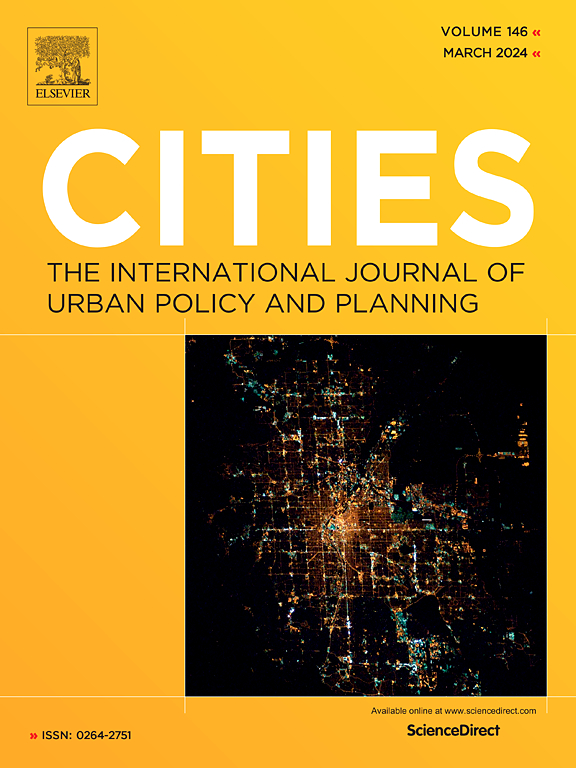城市密度的多重路径:三个城市中心建筑类型变迁的历时性比较分析
IF 6.6
1区 经济学
Q1 URBAN STUDIES
引用次数: 0
摘要
单纯将建筑密度作为量化目标来追求,忽略了如何通过不同的建筑配置来达到相似的密度水平。这种见解要求对致密化进行更细致入微的理解——不仅仅是我们的密度是多少,而是我们如何通过不同的建筑类型来实现它。最近的类型形态学研究采用了先进的定量方法来识别建筑类型,但仍然主要是共时性的,没有深入了解长期的进化模式。本文提出了在历时框架中实施这些方法的第一次尝试之一,以研究建筑类型如何出现并影响不同时期的致密化过程。我们假设城市不是简单地均匀地变得更密集,而是通过各种建筑类型之间的转换遵循不同的密度路径。通过对跨越19世纪至21世纪三个国际城市中心(纽约、墨尔本和巴塞罗那)的新型纵向数据集的分层聚类分析,我们确定了七种不同的建筑类型,并追踪了它们的演变。我们的分析揭示了密度的三个基本途径:(1)紧凑型密度化,城市在保持建筑高度的同时填补可用空间;(2)垂直密度化,在保持地面覆盖的同时增加建筑高度;(3)分散致密化,高层建筑的建造减少了地面覆盖,在建筑之间创造了更多的开放空间。通过将建筑密度测量扩展到历时分析,并将其与机器学习聚类相结合,我们为更具时间意识的城市形态测量学做出了贡献。这种方法丰富了跨国城市形态的比较,并提供了在平衡集约化和环境可持续性的同时实现密度目标的见解。本文章由计算机程序翻译,如有差异,请以英文原文为准。
Multiple pathways to urban density: A comparative diachronic analysis of building type transitions across three city centers
Pursuing built density purely as a quantitative target overlooks how similar density levels can be achieved through different building configurations. This insight calls for a more nuanced understanding of densification - not just how much we densify but how we achieve it through distinct building types. Recent typo-morphological studies have advanced quantitative methods for identifying building types, yet remain predominantly synchronic without insight into long-term evolutionary patterns. This paper presents one of the first attempts to operationalize these methods in a diachronic framework to investigate how building types emerge and influence densification processes across various periods. We hypothesize that cities do not simply become denser uniformly but follow distinct densification pathways through various transitions between building types. Through hierarchical cluster analysis of a novel longitudinal dataset spanning the 1800s–2000s across three international city centers –New York, Melbourne, and Barcelona– we identify seven distinct building types and trace their evolution. Our analysis reveals three fundamental pathways to density: (1) compact densification, where cities fill in available space while maintaining building heights; (2) vertical densification, where building heights increase while maintaining ground coverage; and (3) dispersed densification, where taller buildings are constructed with reduced ground coverage, creating more open space between them. By extending built density measurement into diachronic analysis and combining it with machine learning clustering, we contribute to urban morphometrics with a more time-conscious focus. This methodology enriches transnational urban form comparisons and provides insights into achieving density targets while balancing intensification and environmental sustainability.
求助全文
通过发布文献求助,成功后即可免费获取论文全文。
去求助
来源期刊

Cities
URBAN STUDIES-
CiteScore
11.20
自引率
9.00%
发文量
517
期刊介绍:
Cities offers a comprehensive range of articles on all aspects of urban policy. It provides an international and interdisciplinary platform for the exchange of ideas and information between urban planners and policy makers from national and local government, non-government organizations, academia and consultancy. The primary aims of the journal are to analyse and assess past and present urban development and management as a reflection of effective, ineffective and non-existent planning policies; and the promotion of the implementation of appropriate urban policies in both the developed and the developing world.
 求助内容:
求助内容: 应助结果提醒方式:
应助结果提醒方式:


